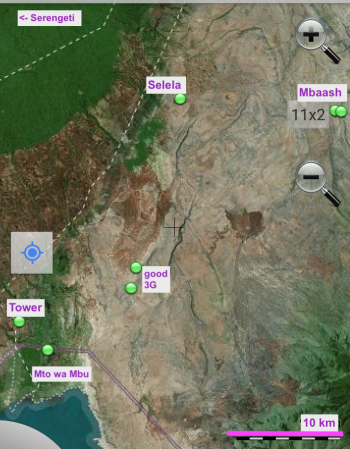DigI:Community Networks in Zimbabwe-Jan2020
From its-wiki.no
| Digital Inclusion (DigI) | |||||||
|---|---|---|---|---|---|---|---|
|
DigI:Community Networks in Zimbabwe-Jan2020
| Title | DigI:Community Networks in Zimbabwe-Jan2020 |
|---|---|
| Place | |
| Date, Time | 2020/01/03, 1000-1200 |
| Contact Person | Josef.Noll |
| Participants | Joseph Bishi, Josef Noll |
| related to Project | DigI, BasicInternet |
| Keywords |
| this page was created by Special:FormEdit/Meeting, and can be edited by Special:FormEdit/Meeting/DigI:Community Networks in Zimbabwe-Jan2020 |
| Category:Meeting |
Topics being discussed
Agreements
We agreed on a cooperation in both knowledge exchange about access and business, as well as looking for opportunities to collaborate for free access to information and digital public goods.
Network infrastructure at Murambinda
Joseph Bishi a chairman for Zimbabwe Community Network Initiatives, has been attended in 4 Africa Community Network Summits hosted by Internet Society since inception in 2016 and in the last 2 years as a member of the program committee member for organization the Africa community network summit.
The «Murambinda Rural Community Network Project» that aims to provide affordable Internet access to the remote rural community in Murambinda, Buhera District. Murambinda is now a local innovation hub potential to build and sustain a multi-node community network to enhance access. The national e- learning, e-health and e-government programs provide the initial anchor points for the network. Murambinda Works went into partnership with TelOne, the service provider having widest fibre coverage in rural Zimbabwe. Murambinda Works offers affordable internet access to rural schools, health facilities, government institutions and community at large at a revenue sharing basis through the partnership with TelOne.
Murambinda works provides access through a bulk shared connection where costs of connectivity are shared among the community depending on capacity but eventually accommodating everyone. A school automated management software is a system deployed with the network as this will be an element that will add value to the network. Where schools can use for school management purposes at the same time these schools becoming local hubs for development of local content, locally hosted by Murambinda works, which will be accessed by the community from the local network hotspots some service at free costs and others at affordable price.
The current infrastructure powered by solar connects 8 schools having a capacity to connect 80 of the 216 schools in the district. The schools only need a Customer Premise Equipment (CPE), catching up radio links up to 16 km from the sectorial antennas built to connect these schools. The schools mentioned here are the schools currently connected after support from the Internet Society. Regardless these schools there are business entities connected. From community engagement meeting which was conducted in Murambinda on the 15th of November 2018 which was attended by many schools from the district and there was great interest shown in having access to connectivity from their schools.
In Murambinda, they connected a total of 216 schools through radio links. The backhaul is terminated in the fibre of Telone, and from there radio links are used to reach the schools, health spots and village centres (NEST?). Telone has fibre out to the districts, and works with Buhera ICT. https://www.herald.co.zw/telone-partners-buhera-ict-to-set-up-network-system/amp/
Activities in the last years were to get the regulatory conditions in place, a.o. establishing a lite license for the operation of community networks.
Business model
The business model is based on cost sharing with all the partners in network:
- CAPEX connetivity costs: largely provided by the Internet Society, and by private investments
- OPEX fibre costs: covered by TelOne(?)
- Subscription costs: ??
Basic Internet Foundation
The Basic Internet Foundation was founded by University of Oslo and Kjeller Innovation, to focus solely on "connecting the unconnected". Given the OPEX costs of access, main focus is on a business model for access and an architecture for free provision of information to all.
- "Internet lite" is the walking and cycling on the Internet, based on a set of light-weight protocols (e.g. accelerated mobile pages) and proxys for the Internet
- Village information spot, providing free access to information for everyone. Thus, contribute digital inclusion, societal empowerment, and to regain trust in ICT.
The Basic Internet infrastructure, see BasicInternet:Solutions is based a directive antenna to reach out to mobile towers being more than 20 km away, accompanied with a local network control center and a village information spot. Examples of connectivity are the village of Selela, reaching the mobile tower being more than 20 km away.
A village/school/health information spot with free access to “Internet lite” provides free access to information on health, education, agriculture, woman entrepreneurship. Local information in form of pictures and animations (for health information) reaching literate and illiterate locals. A test phase of the village spot has revealed amazing results with a generated medical knowledge increase from less than 20% to 70%.
- See knowledge uptake based on digital health messages: page 12 Media:201910_DigitalPublicGoods_Visjon2030_Noll.pdf
- in our collaboration with Global Health Media https://globalhealthmedia.org/videos/, we have identified the need of getting these videos out
So far the foundation has connected 10 villages in Tanzania, see DigI:Villages, and is now reaching out to Kenya, Uganda, Ethiopia, Ghana and Mali. The results on knowledge increase have a significant impact for individuals and therefore communities, the country and eventually a global impact. Here we ask for help from UNDP for:
- a) Getting the knowledge on Information Spots for education, health, agriculture and innovation out to the world
- b) Promoting the free access to digital public goods (DPGs) through a lightweight Internet (Internet Lite).

